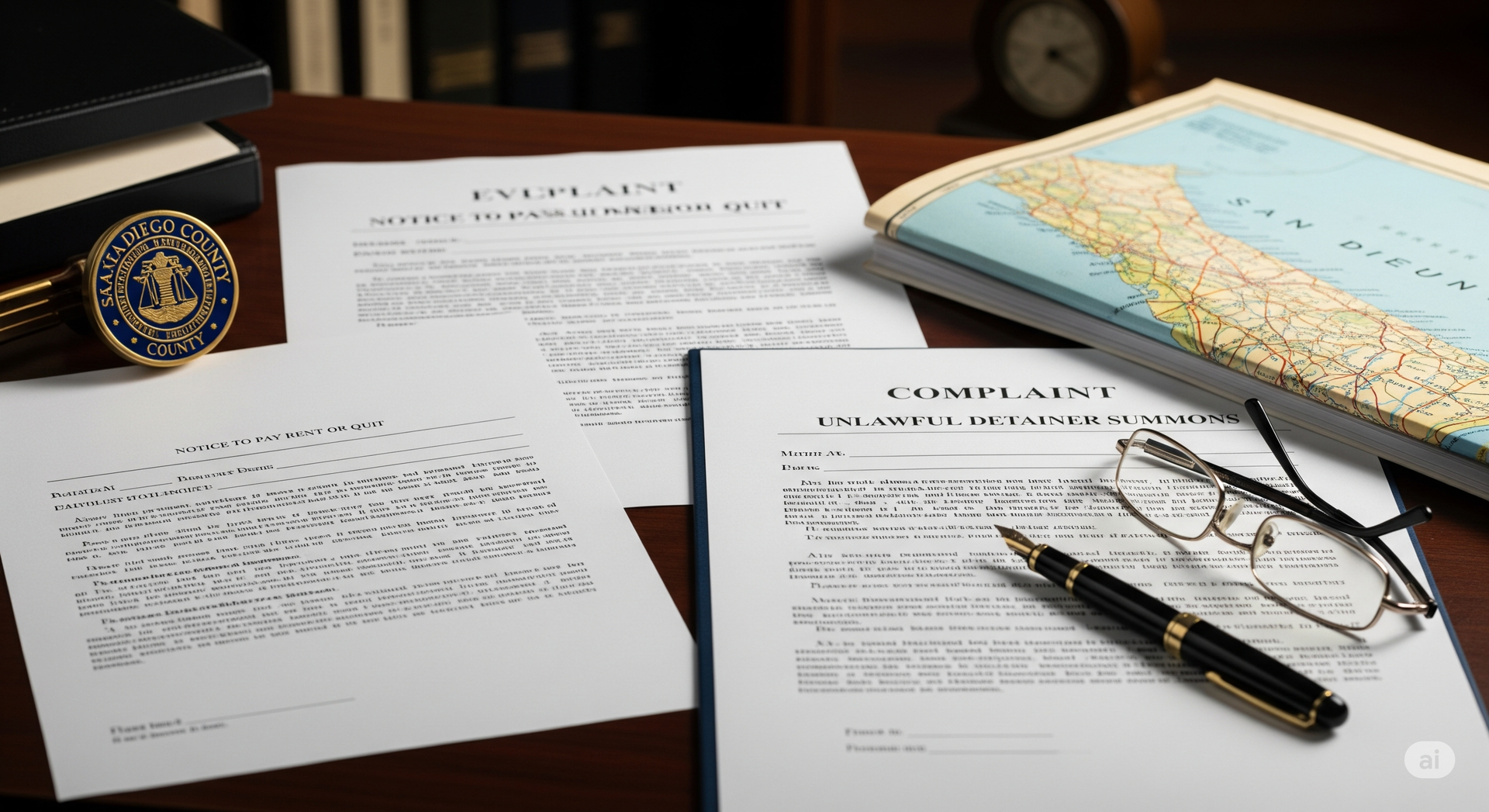Evictions in San Diego County: A 2025 Guide for Landlords

Navigating Evictions in San Diego County: What Landlords Need to Know in 2025
Evicting a tenant is never a landlord's preferred course of action, but sometimes it becomes a necessary step to protect your property and financial interests in San Diego County. As we move towards 2025, understanding the current legal landscape and anticipating potential changes is crucial for landlords operating within San Diego County, including Oceanside. This blog post will provide an overview of the eviction process and key considerations for landlords in the coming year.
Disclaimer: Landlord-tenant laws are subject to change. This information is for general guidance only and should not be considered legal advice. Always consult with a qualified attorney for advice specific to your situation and the most up-to-date regulations in San Diego County.
Understanding the Grounds for Eviction in San Diego County
In San Diego County, as in the rest of California, landlords can typically pursue eviction for the following legal reasons:
- Non-Payment of Rent: Failure by the ten
- ant to pay rent by the due date outlined in the lease agreement.
- Violation of the Lease Agreement: Breach of any other significant term of the lease, such as unauthorized subletting, keeping unapproved pets, or engaging in illegal activities on the premises.
- Nuisance: The tenant's actions are disturbing other tenants or neighbors, causing damage to the property, or interfering with the landlord's rights.
- Unlawful Detainer After Lease Expiration: The tenant remains on the property after the lease term has ended and has not entered into a new agreement.
- Owner Move-In (OMI): In certain circumstances, a landlord may evict a tenant if the landlord or a close family member intends to occupy the property. Specific rules and notice periods apply to OMI evictions.
- Withdrawal of the Property from the Rental Market (Ellis Act): Landlords may evict tenants if they intend to take the property off the rental market. This action also has specific regulations and notice requirements.
The Eviction Process in San Diego County: A Step-by-Step Guide
While specific details can vary, the typical eviction process in San Diego County involves the following steps:
- Serve a Notice to the Tenant: The first crucial step is to serve the tenant with a proper written notice. The type and length of the notice depend on the reason for the eviction:
- 3-Day Notice to Pay Rent or Quit: Used for non-payment of rent. It gives the tenant three days to pay the outstanding rent or vacate the premises.
- 3-Day Notice to Cure or Quit: Used for lease violations other than non-payment. It gives the tenant three days to correct the violation or move out.
- 30-Day or 60-Day Notice to Quit: Used for month-to-month tenancies when the landlord wishes to terminate the tenancy without cause (in compliance with legal requirements) or for reasons like OMI or Ellis Act (longer notice periods may apply). The length of notice depends on how long the tenant has resided at the property.
- Important Considerations for Notices:
- The notice must be in writing and clearly state the reason for the eviction, the specific actions required (if any), and the deadline for compliance.
- The notice must be properly served to the tenant according to California law (personal service, substituted service, or posting and mailing). Improper service can invalidate the eviction process.
- File an Unlawful Detainer Lawsuit: If the tenant fails to comply with the notice (i.e., doesn't pay rent, cure the violation, or move out by the deadline), the landlord can file an unlawful detainer lawsuit with the San Diego County Superior Court.
- Serve the Summons and Complaint: Once the lawsuit is filed, the tenant must be officially served with a copy of the summons and complaint. This must be done according to legal procedures.
- Tenant's Response: The tenant has a limited time (typically five court days) to file a formal written response (an Answer) with the court.
- Court Proceedings:
- Mediation: In some cases, the court may encourage or require mediation to attempt to reach a settlement between the landlord and tenant.
- Trial: If no settlement is reached, the case will proceed to trial where both the landlord and tenant can present their evidence and arguments to the judge.
- Judgment: If the landlord prevails at trial (or if the tenant fails to respond to the lawsuit), the court will issue a judgment in favor of the landlord. This judgment will likely order the tenant to vacate the property.
- Writ of Possession: If the tenant still refuses to leave after the judgment, the landlord must obtain a Writ of Possession from the court. This is a legal document that authorizes the San Diego County Sheriff's Department to physically remove the tenant from the premises.
- Eviction by the Sheriff: The Sheriff's Department will serve the tenant with a notice to vacate, usually giving them a final opportunity to leave voluntarily. If they still remain, the Sheriff will return to the property to conduct the eviction.
Key Considerations for San Diego County Landlords in 2025
- Local Ordinances: Be aware of any specific eviction-related ordinances that may be in place within individual cities or jurisdictions in San Diego County, including Oceanside. These ordinances might provide additional tenant protections or impose specific requirements on landlords.
- Just Cause Eviction: California law has statewide "just cause" eviction requirements, meaning landlords generally need a legally recognized reason to terminate a tenancy after a tenant has resided in the property for a certain period. Understand these requirements and ensure your grounds for eviction meet the legal standards.
- Rent Control: While California has a statewide rent control law (AB 1482), it's essential to understand its applicability to your property in San Diego County. Some exemptions may apply, but generally, it limits annual rent increases and requires just cause for eviction after the initial 12-month tenancy.
- Emergency Protections: It's important to stay informed about any potential state or local emergency orders or legislation that might impact eviction procedures or timelines. These can change rapidly in response to unforeseen circumstances.
- Documentation is Crucial: Maintain thorough and accurate records of all communications with the tenant, lease agreements, notices served, and any other relevant documentation. This will be essential if an eviction lawsuit becomes necessary.
- Seek Legal Counsel: Given the complexities of eviction law, it is highly recommended that San Diego County landlords consult with an attorney experienced in landlord-tenant matters before initiating any eviction proceedings. An attorney can ensure you are following all legal requirements and protect your rights.
Conclusion
Navigating evictions in San Diego County requires a thorough understanding of California law and any local ordinances. By staying informed about the legal grounds for eviction, following the correct procedures, and seeking legal counsel when necessary, landlords can protect their investments while adhering to their legal obligations. As we look towards 2025, proactive preparation and a commitment to legal compliance will be essential for San Diego County landlords, including those managing properties in Oceanside.





